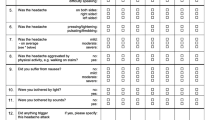Abstract
Trigger points play a part in the development and maintenance of chronic headache states. This article reviews the physiology of trigger points, with a focus on the latest understanding of their biochemistry. The importance of facial muscle and extraocular muscle trigger points is only beginning to be understood; the data exploring their role in headache are reviewed. The concept of central sensitization and the way in which it relates to trigger points and headache is explained, along with treatment strategies for helping patients with their pain.
Similar content being viewed by others
References and Recommended Reading
Giamberardino MA, Tafuri E, Savini A, et al.: Contribution of myofascial trigger points to migraine symptoms. J Pain 2007, 8:869–878.
Bennett R: Myofascial pain syndromes and their evaluation. Best Pract Res Clin Rheumatol 2007, 21:427–445.
Schmidt-Hansen PT, Svensson P, Jensen TS, et al.: Patterns of experimentally induced pain in pericranial muscles. Cephalalgia 2006, 26:568–577.
Gerwin RD, Shannon S, Hong CZ, et al.: Interrater reliability in myofascial trigger point examination. Pain 1997, 69:65–73.
Sciotti VM, Mittak VL, DiMarco L, et al.: Clinical precision of myofascial trigger point location in the trapezius muscle. Pain 2001, 93:259–266.
Davidoff RA: Trigger points and myofascial pain: toward understanding how they affect headaches. Cephalalgia 1998, 18 :436–448.
Rosendal L, Larsson B, Kristiansen J, et al.: Increase in muscle nociceptive substances and anaerobic metabolism in patients with trapezius myalgia: microdialysis in rest and exercise. Pain 2004, 112:324–334.
Kapel L, Glaros AG, McGlynn FD: Psychophysiological responses to stress in patients with myofascial pain-dysfunction syndrome. J Behav Med 1989, 12:397–406.
Ong JC, Nicholson RA, Gramling SE: EMG reactivity and oral habits among young adult headache sufferers and pain-free controls in a scheduled-waiting task. Appl Psychophysiol Biofeedback 2003, 28:255–265.
Fernandez-de-las-Penas C, Alonso-Blanco C, Cuadrado ML, et al.: Myofascial trigger points and their relationship to headache clinical parameters in chronic tension-type headache. Headache 2006, 46:1264–1272.
Fernandez-de-las-Penas C, Ge HY, Arendt-Nielsen L, et al.: The local and referred pain from myofascial trigger points in the temporalis muscle contributes to pain profile in chronic tension-type headache. Clin J Pain 2007, 23:786–792.
Yanguela J, Sanchez-del-Rio M, Beuno A, et al.: A new cephalgia generated and modulated on the trochlear region. Neurology 2004, 62:1134–1140.
Fernandez-de-las-Penas C, Cuadrado ML, Gerwin RD, et al.: Referred pain from the trochlear region in tension-type headache: a myofascial trigger point from the superior oblique muscle. Headache 2005, 45:731–737.
Fernandez-de-las-Penas C, Cuadrado ML, Gerwin RD, Pareja JA: Referred pain elicited by manual exploration of the lateral rectus muscle in chronic tension-type headache. Pain Med 2008 Mar 11 (Epub ahead of print).
Fernandez-de-las-Penas C, Cuadrado ML, Gerwin RD, Pareja JA: Myofascial disorders in the trochlear region in unilateral migraine: a possible initiating or perpetuating factor. Clin J Pain 2006, 22:548–553.
Bendtsen I: Central sensitization in tension-type headache—possible pathophysiological mechanisms. Cephalalgia 2000, 20:486–508.
Fernandez-de-las-Penas C, Cuadrado ML, Arendt-Nielsen L, et al.: Myofascial trigger points and sensitization: an updated pain model for tension-type headache. Cephalalgia 2007, 27:383–393.
Ho KY, Tan KH: Botulinum toxin A for myofascial trigger point injection: a qualitative systemic review. Eur J Pain 2007, 11:519–527.
Bhidayasiri R, Truong DD: Expanding use of botulinum toxin. J Neurol Sci 2005, 235:1–9.
Jakubowski M, McAllister PJ, Bajwa ZB, et al.: Exploding vs. imploding headache in migraine prophylaxis with botulinum toxin A. Pain 2006, 125:286–295.
Fricton JR: Management of masticatory myofascial pain. Semin Orthod 1995, 1:229–243.
Author information
Authors and Affiliations
Corresponding author
Rights and permissions
About this article
Cite this article
McMurray, C.A., Bajwa, Z.H. The role of extraocular and facial muscle trigger points in cephalalgia. Current Science Inc 12, 350–354 (2008). https://doi.org/10.1007/s11916-008-0059-5
Published:
Issue Date:
DOI: https://doi.org/10.1007/s11916-008-0059-5




